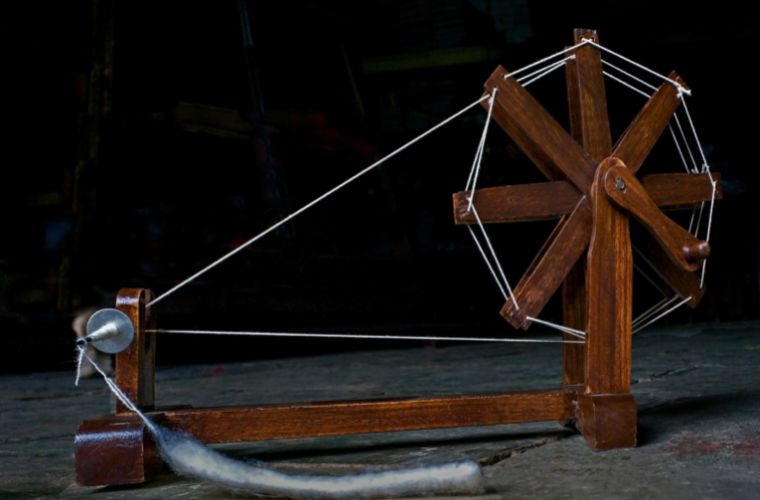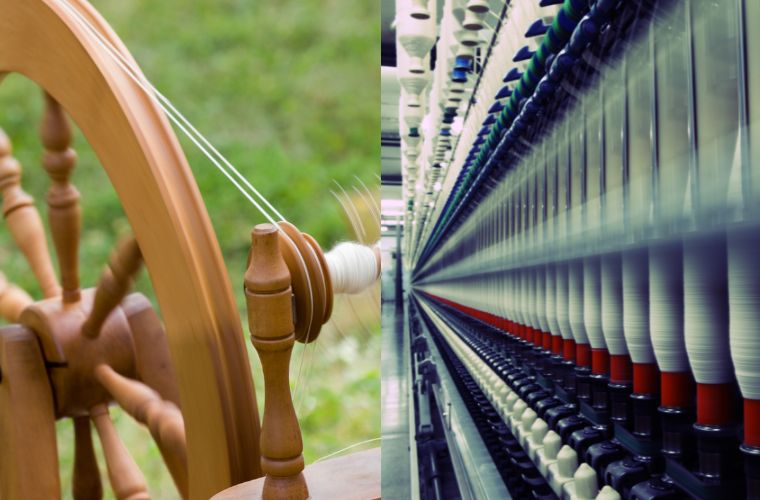Indian Sarees have come a long way since British rule.
Do you know the history behind the spinning wheel and the transition of the spinning wheel to the spinning mill?
The Spinning wheel was first used by the Indus Valley people to produce a tight weave.
Dieter Kuhn and Weiji Cheng said that the birthplace of the spinning wheel was China.
C. Wayne Smith and J. Tom Cothren were of the opinion that the spinning wheel was first invented in India between 500-1000 AD.
According to Arnold Pacey and Irfan Habib, the spinning wheel was most likely designed in the Islamic world.
K. A. Nilakanta Sastri and Vijaya Ramaswamy said that there is clear evidence that the spinning wheel originated in India by the 12th century.
Mark Elvin said that the Chinese people first developed an automatic water-powered spinning wheel in the 14th century.
There are many types of spinning wheels that are widely used by artisans to spin threads or yarn.
Types of Spinning wheel
Charkha

Charkha is one of the oldest forms of the spinning wheel. The charkha works with a drive wheel being turned by one hand, while it spins the yarn off the tip of the spindle with the other. Both the charkha and great wheel work in the same way.
The charkha as a tool was used for spinning threads and came into the picture during the Indian independence movement. Mahatma Gandhi taught people how to use charkha to achieve self-sufficiency and independence. During the Swadeshi Movement, Mahatma Gandhi encouraged every Indian to spin the yarn using Charkhas and wear Khadi, a traditional cloth of India.
Great Wheel
The great wheel, one of the age-old spinning wheels, is operated by holding the fiber in the left hand and slowly turning the wheel with the right hand. This wheel is usually over 5 feet in height. The yarn is spun off the tip of the spindle and then stored on the spindle. The Great Wheel is designed in such a way that it’s easy to create long drawn soft silky wools, but difficult to create strong smooth yarns.
Treadle Wheel
This type of wheel operates by the spinner’s foot. Treadle Wheel leaves the spinner’s hands free to draft the fibers. It has a pointed-driven spindle which is used for spinning and twisting fibers into yarn.
Electric Spinning Wheel
Electric spinning wheels run on electric motors rather than through a treadle. It operates both on electric power and a rechargeable battery. Most electric spinners are small and portable. Electric spinners are easier to use than treadle wheels.
The spinning wheel was rudimentary in the textile industry before the Industrial Revolution. It laid the ground for other machines, like spinning jenny and spinning frame. These two machines superseded the spinning wheel during the Industrial Revolution. The phase of the Industrial Revolution included shifting from hand production methods to machines and the use of steam power and water power in large numbers. During the Industrial Revolution, it was the textile industry that created more employment, more output, and heavy capital investment.
After Independence, both spinning wheels and spinning mills continued to operate in India to fulfill the cloth needs of people. Machine-spun yarn, known as Handloom and Hand-spun yarn, known as Khadi, were widely used and became affordable for everyone.
But there is a tremendous difference between the current and post-independence periods. The handloom sector is facing competition from cheap imports. Measures taken by the government to protect the handloom and khadi industry are very low. The cost of natural fabric has gone up, making traditional handloom clothes unaffordable for common people.
High-level competition in the handloom sector compels weavers to quit their age-old profession and move to unskilled labor work. But India has not lost the charm of its cultural and traditional sarees. It’s still there, people are looking for handloom sarees on special occasions, cultural programs, festivals, and wedding ceremonies. They proudly wear traditional sarees in various events in different states and countries to increase the market value of our handloom products.

Conclusion
The journey of the Indian saree from the spinning wheel to the spinning mill has been a long one, narrating the function of various spinning wheels and the widespread use of the saree that created more employment in India. Saree has been a unique and appealing outfit for Indian women. It may be Handloom or Khadi, Indian women are experts in draping it around their body and giving a decent look to their personality with Indian Sarees.

